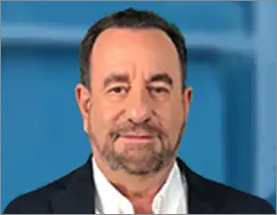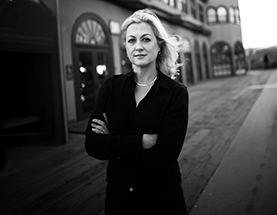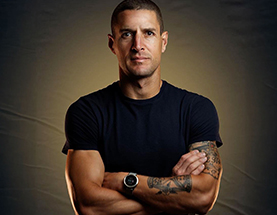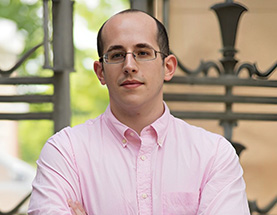
Support Us
Donations will be tax deductible
Gordon Krass, CEO of IntelliGuard, discusses how the late-stage startup company is making the medication supply chain within U.S. hospitals safer and more efficient.
You will learn the following:
With the use of radio-frequency identification (RFID) technology and data analytics, IntelliGuard has one ultimate goal in mind: maximizing positive healthcare outcomes for patients.
Krass explains that while hospitals in the U.S. today are on the cutting-edge of the clinical side of the business with the use of AI in surgeries, new procedures, and advanced imaging technology, the infrastructure that’s responsible for running hospitals is outdated, relying far too heavily on paper-based documentation and human interaction.
“People think the supply chain of medications is secure, the truth is it’s not,” says Krass, citing a 60 percent accuracy rate for inventory of critical medications used in surgeries and other complex procedures. This inadequacy is a dangerous one, leading to the administration of expired, recalled, incorrect, or counterfeit drugs.
Aside from labor, drugs and supplies are the highest cost items in hospitals, but despite this, hospitals don’t know where medications are or how much they have on hand at any given time. “Most businesses would not be in business if they operated in this way,” says Krass.
He continues by explaining the details of how IntelliGuard is working to address these issues, where some of the greatest weaknesses lie in the current system, and how IntelliGuard technologies will transform hospital infrastructure in the U.S. for the better.
Press play for all the details. For more info, visit https://ig.solutions/.
Richard Jacobs:
Hello. This is Richard Jacobs with the Finding Genius podcast. I have Gordon Krass. He’s the CEO of a company called IntelliGuard. We are going to be talking about clinical inventory management, intelligent solutions, and distribution. We’ll get into what that means shortly, but Gordon, thanks for coming. How are you doing?Gordon Krass: I’m doing fine. Thank you for having me.
Richard Jacobs: Tell me if you would briefly, what’s the premise of IntelliGuard? What do you guys do?
Gordon Krass: Sure. We’re a late-stage startup company. We use RFID technology, software, and data analytics to really improve the supply chain of medications within hospital and ultimately make for a much safer patient orientation. So we’re looking at patient safety, we’re looking at efficiencies, we’re looking for improved outcomes.
Richard Jacobs: What happens with the medication distribution right now? Is it that they run out because no one’s tracking them, or do they give the wrong medication to a patient? Like what are the big challenges in the industry?
Gordon Krass: Well, this is one of the myths that I think are misperceptions that people have about how hospitals are run. But one of the most remarkable things I’ve seen as I’ve gotten engaged and involved with this business is hospitals in the US today are cutting edge on the clinical side of the business. We’re using robots to do surgery. We have incredible imaging technologies. We’re doing procedures that were done five years ago. We’re doing imaging that wasn’t done five years ago. So that how the overall clinical side is highly advanced. Yet the infrastructure that runs a hospital is 40 years behind the times. It’s old technology. Most of it is still paper. Most of is still human interactions. Humans make mistake. And while people think the supply chain medications are secure, the truth is it’s not.
Richard Jacobs: That’s bad. I notice, I go to the doctor and I’m still handed a clipboard with paper. It’s weird. Or like, why don’t they give me an iPad? And when I’ve gone to the hospital, I may ask the same stuff like 10 times by different people and it looks like it’s going into a computer. But I don’t know if anyone’s looking at it or if they think I’m lying. And then when they asked me five times, I mean, why is this happening?
Gordon Krass: Well, it’s happening because the investment that hospitals are making is clinical. It’s not infrastructure. So as an example, in the business, we’re in and the supply chain of medications and this includes critical medication such as narcotics that are used in the operating room, procedure layers and surgery, very important medications. The average inventory accuracy, meaning that where are the drugs, how many do I have, is about 60% I don’t know any private industry today that could manage their business with only having a 60% accuracy on their inventory. And the fact is this in today’s environment is highly unusual. And what it means is it means errors. It means medication errors. It means patients are given drugs that are expired. It means patients are even given drugs that have been recalled and patients have been given the wrong drugs. So it makes for a very complex environment and it shouldn’t be that complex.
Richard Jacobs: Well, it’s only that people’s lives are at stake. So it’s no big deal. Right. Just kidding. But I mean, are hospitals held to task if they have a high or a bad outcome for a given condition or for all their conditions? I mean do the hospitals care? Is there any incentive to make this better?
Gordon Krass: You know, number one, I want to be clear. I think hospitals care. I think the people that work at the hospitals care, but you’re dealing with a hospital infrastructure that has multiple silos. The pharmacy is a silo. The administration’s a silo. The clinical is a silo and materials management is a silo. All of these things are not looking at the greater good. They’re not looking at what the large problems are. So as an example, in the space that we’re in, drugs and supplies are the highest cost items within a hospital. Second behind labor, which is the highest costs yet they don’t know where particular medications are. They don’t know what they have on hand. There are counterfeit drugs getting into the supply chain. There are diversion of narcotics occurring in the clinical areas of the hospital. If, as I said, most businesses would not be in business if they operated this way and the hospital simply have not invested on infrastructure and particularly with the types of technologies that are available today, such as RFID, such as cloud-based computing that would allow them to address and fix all these problems.
Richard Jacobs: So, all right. I guess you can’t focus on everything, so you’re focused on the medication side of it, right?
Gordon Krass: Yes. There’s a lot of applications that are available. We chose medications for a couple of reasons. Number one, it has a big impact on the patient and one of the most important drivers that we have as a company, something I talked to all the employees about is regardless of what you do in this company, there’s a patient at the end of it. So patient safety is a very important driver for us as a company. And that’s why we chose medication. The second reason we chose medication and this application is because it’s a very hard thing to do with the technologies we’re doing. You’re talking about all different form factors. You’re talking about vials, you’re talking about syringes, you’re talking about ampules and they’re all over the hospital. They’re not just in pharmacy, they’re in the operating room, procedure layers, on the floors and the nursing stations. So managing this is a very complex environment. Our thinking was if we could crack the code on doing that in pharmacy and the operating room, we can pretty much manage any problem going forward.
Richard Jacobs: So. Okay. Are you starting with the pharmacy and the hospital or you’re looking more downstream to, again, procedures on how to administer the medications or track them once they’re out of the pharmacy?
Gordon Krass: Yeah. Good question. And we started with the pharmacy and we enable the technology and I want to talk a little bit about RFID so that the listeners can understand the premise of RFID. So, because not everybody does, but simply put in an analogy that I think everybody understands is we all go grocery shopping. So when you go grocery shopping, you fill up a cart, you put your items on a conveyor belt, and then you see it has to go one at a time through a conveyor belt and be scanned by a barcode. That is traditionally how things are done in hospitals today. The difference with RFID is imagine taking a basket, tapping your credit card on an RFID reader on the basket, going through the grocery store, filling it up, and then walking out the door and it automatically in seconds captures the 50, 75 items that you have with incredible accuracy and it goes on your credit card. That’s what we’re doing in medication management today. They’re either doing it manually, hand counting. You’d be amazed how many drugs are being hand-counted on a regular basis or they’re using barcodes. But barcodes are not effective. They don’t work because they are counter to the workflows that clinicians do. So we started in the hospital pharmacy. That was where we begin the process and then we have now moved to what is, we consider the hardest area to manage, which is the operating room. Because these drugs in the operating room, not only they are plentiful, but they include controlled substances such as morphine, such as fentanyl, very important drugs to monitor and manage. And effectively today, those systems are not in place.
Richard Jacobs: It’ll be really cool if you could also have it either a level or a weight sensor if there was a cheap enough way to do it on all these bottles. So not only you could see where they are in real-time, but you can see the levels of them in real-time. That would be super cool.
Gordon Krass: Yeah, we’re not using that, but what we do is we have a system so that the inventory is managed automatically. So as an example, what you’re talking about is you’re an anesthesiologist. Our workflow is as simple as you can get. It’s open the drawer, take out what you want, close the drawer, take care of your patient. In the background, we’re scanning every vile in there where you would know exactly what they pulled out. And at the end of the case, we have a software package that does what’s called a waste witness. So it actually captures by individual item what was administered to the patient, what was wasted and you get a full accounting record from end-to-end and that all that data goes to the pharmacy. And then on top of that, we have a data analytics engine where we throw all this data into a data analytics engine that provides decision-making capabilities that quite frankly today pharmacists aren’t making because they didn’t have the data available to do it.
Richard Jacobs: Well. The other part of it too is that whenever medication is being dispensed either an ampoule or whatever form it’s going into someone. So if it also simultaneously recorded and updated that patient’s record, as you know, John Smith got eight milliliters of X at this time, it will be a totally end to end solution to record everything.
Gordon Krass: Well that a great segue into what we do because we, in addition to doing all of this on our anesthesia system and our pharmacy systems, those systems are connected to the electronic health record so that every item dispense, we know the patient, we know a lot about that patient in terms of allergies and we capture all dispense items that went to that patient. So we not only create a clinical record, but we create an accurate billing record. So charge capture becomes a real value proposition for the hospital because of this system that exists today. That’s highly manual. They’re missing a lot of charge capture.
Richard Jacobs: Hmm. Okay. Very interesting. Yeah, I can see why this would be a huge help. Have you done any pilot studies, other hospitals that are using like the full implementation of what you do and how much better their outcomes have?
Gordon Krass: Yeah, and the answer is yes. So there are several areas I’ll talk about this a few of them. But if you talk about from a pharmacy standpoint, we’re hearing from our directors of pharmacy that they have regulations that they have to meet their required and they get audited along with these regulations. They’ve had really difficult times managing manual processes with an auditor. This automates everything. So there’s literally an electronic record that an auditor can see and we’re hearing directors of pharmacies tell us this is the most advanced automated system for managing medications they’ve ever seen. It’s giving them peace of mind because they know if an auditor walked in that they’re going to have all the data available to show them exactly where the track and trace of every item is. That hadn’t existed before from the anesthesiologist standpoint who administers the medication. Are systems that exist today are either manual, they’ve got a handwrite them or they have to use barcode scanning. So imagine that anesthesiologists being out that checkout person at the grocery starts scanning every individual item. Every time they do that, they’re not focusing on the patient. What we’ve been able to do and what they’re telling us is we simplify their workflow so they can now focus on the most important thing, which is the patient. And then we provide a full reconciliation, which makes their life easier. So anytime you make a clinician’s life easier, they’re going to like what you’re offering.
Richard Jacobs: Oh, I didn’t bring up this, but generic versus branded drugs. I’ve read a book called a bottle of lies and it was about Ranbaxy and some of these other companies that, you know, the generics are made of God knows what. So I don’t know if hospitals used generics all the time or that could play into, unfortunately, I mean, if something goes wrong in the hospital with your system, they’d probably be much more likely to track it back and say, Ooh, when we gave this drug X we had like a 30% jump in bad outcomes. So we’ve got to look into it. Even though the FDA hasn’t recalled it, something’s wrong, you know.
Gordon Krass: Yes. And you’re bringing up a very interesting and important topic, not just around generics but also the counterfeits that are coming into the supply chain. So today it’s virtually impossible to go back and do a track and trace of any individual item that was given to any individual patient other than handwritten records. We automate that. So by the fact that we’re capturing every single item all the way down to what’s called the NDC number. So the actual ID of that particular medication through the supply chain. We’ve got a record from end to end and this plays very well. And the reason why it’s important you brought this up is that the Congress has passed a law called the DSCSA, which really is in simplified terms a requirement from pharmaceutical companies to track and trace every drug that goes through the supply chain. And today there is an effective technology to do that. RFID provides a really compelling answer to providing an end to end track and trace solution, in addition, has some unique properties that can authenticate the actual brand that the drug that was given that was branded with a particular pharmaceutical company is actually coming from that pharmaceutical company.
Richard Jacobs: Right. I knew about generics, but I didn’t realize that counterfeits, like how pervasive is that?
Gordon Krass: It’s a bigger problem than what people acknowledge. But counterfeit drugs, particularly opioids as well as narcotics are getting into the supply chain where they’re actually leaving the supply chain to from bad actors who are shipping back bottles that are replicas of the original. But unfortunately what’s inside those medications is probably water or something that certainly is not representative of what the drug has given. The impact of that is significant because those drugs can end up going to a patient. And there are lots of examples of where patients are given pain medication, for example, not showing any relief of pain. And the reason is, is because it was counterfeited or altered in some way. This is also happening because of what they call diversion, which is a nice way of saying theft, but the diversion at hospitals of narcotics and it’s leaking through even at the clinical levels and an alarming rate. So it’s a significant problem. And as it occurs, because there’s virtually no accountability tracker trace of medications today. So we close that gap and hospitals, it’s another area you asked earlier, but one of the things we hear from hospitals is that they really believe they’re addressing the problems associated with diversion and counterfeiting in ways that they didn’t know was possible.
Richard Jacobs: Hmm. Amazing. Afraid to go to the hospital.
Gordon Krass: It’s really true. And I talk about this with hospital executives whenever I get the opportunity, but you know, we’re on the cutting edge of medicine where we’re seeing robots doing robot-assisted surgery. We’re seeing unbelievable imaging capabilities. We’re seeing bio meds that are doing things that we didn’t think possible five years ago. The clinical side is extraordinary, the best in the world. Yet the infrastructure side is really behind the times. In fact, it’s probably based on 40-year-old technologies or manual processes. And it has not caught up because the investment hasn’t been made. So there’s a huge opportunity to bring it into the modern world, and that’s one of the things we’re trying to do with our technologies.
Richard Jacobs: Wow. So what kind of responses are you getting? I mean, how many hospitals have you approached and there are a lot of them like, Oh, please help us. Or are they resisting?
Gordon Krass: Well, our technologies and managing medications is used today in about 500 hospitals in some way, shape, or form. We’ve just recently introduced the anesthesia product late last year and we are in four hospitals adding the fifth hospital in by the end of this month. And the response is very positive.
Richard Jacobs: Yeah, that’s great. That’s excellent. So what does a full rollout look like? Like how ambitious is this going to be the new standard hopefully if you can get allowed to with hospitals?
Gordon Krass: We are hoping that it will be the new standard. We think it’s a very compelling technology that solves a lot of problems. We pick pharmacy as a starting point. As I mentioned, we rolled into the OR because it was the hardest area to manage, but then you start going out where medications are managed across the spectrum of health care to include the nursing floors to include the procedure layers, the outpatient clinics all the areas that manage medications. You need this capability of being able to track and trace in order to provide an environment that provides safe medication practices for the caregivers and most likely for the patients. And in that vein, one of the reasons that I’m, if you can tell I’m very passionate about this, I’m very excited about this as one of the things I did before coming to this company was I looked at other industries. RFID has been around a long time and retail is probably the most advanced application, but it’s used in airlines. It’s used in industrial. But Macy’s, for example, we’ll put an RFID on a $20 bill and they’ll know the pedigree of that belt from the point of manufacturing through the distribution chain. When it hit the big box store, what shelf it was on, when somebody bought it and when it walked out the door. But yet today a hospital can’t find a $20,000 medication. There is something wrong with that. And that’s what drives us to address these issues because that should be the safest environment. That should be the environment where inventory accuracy is 99.99%, not 65%
Richard Jacobs: Yeah. Yup. You know, years ago when I, well not too long ago, probably three years ago, two years ago when I did a call like this, maybe like talking about blockchain and blockchain about you know, for everything. Is that necessary that there a high level of security needed for all this or is it really just get the system in place and then go from there? Like how does security play in?
Gordon Krass: It’s a great question. So I’m going to really start with the data because that’s really what you’re talking about. So in order to secure the supply chain, you’ve got to see the data system, whether its blockchain or anything else that you would use, any type of ledger system, you need to make sure that the data going in is accurate. That’s the biggest challenge because if it’s bad data going in, it doesn’t matter where throughout the supply chain it’s bad data throughout the supply chain. So to secure the supply chain blockchain is a wonderful answer. Because of all the security and openness that it does. So it’s that good balance between being a proprietary yet being open and allowing for security, but you got to make sure that the data going in is important. The second part of that is that most of the hospitals today on their infrastructures and this is probably part of the handcuffs, so to speak, that they have, are using very antiquated premise base solutions for their data management. They’ve got server rooms, they’ve got data rooms. With the cloud, you have so much capability. Well, whether it’s Amazon Azure to not just secure data in a HIPAA cloud that’s already certified, but to scale and expand in ways that weren’t possible with these other types of systems. So when you look at scalability, when you look at security in the cloud, and then you add elements like blockchain, now you’re starting to get to a full-blown solution for the DFCSA for the full track and trace end to end. But the key element of that is making sure that the item data that are fed to these systems have the level of accuracy that you want.
Richard Jacobs: Okay. Yeah, that makes sense. I don’t know if you’re able to say, but again, how much of an improvement and what does it look like? What are your KPIs for improvement? And can you say what they are? At least the ranges or if you don’t know what’s possible.
Gordon Krass: Sure. So I can share with you what the KPIs are and some of the important elements that our customers look at. So we look at workflows and work processes and improvements on efficiencies. So that’s one area. That’s KPIs and we’ve got clinical studies, case studies that show a very substantial work improvement workflow improvement, which with those improvements you reduce the propensity of errors. We have an area of charge captures. Charge capture is a very important area. We’re seeing our customers tell us over 40% improvement in charge capture that helps the hospital financially, but it also helps the patient because you know that their bill is accurate going in because of the ability to track at the item level. Some of the other pieces of this is the whole area of optimization of inventory. So how do you manage an inventory that you can’t see or that you can’t manage without the accuracy and the data analytics that allows making predictions of saying, look at if you optimize your inventory this way, you can take 20% of your inventory. That’s a big number when you look it up hospital inventory, spending $500 million a year on medications. So there’s a lot of elements to this. That really pays off. And the most important element personally as well as for us as a company is making sure that no expired drugs get into the supply chain and get to a patient, making sure that if a drug is recalled, it’s pulled out of the system and doesn’t inadvertently get to a patient or that a counterfeit product doesn’t get to a patient. Those are the most important elements as I talk about that there’s a patient at the end of everything we do.
Richard Jacobs: Yeah, definitely. Well, it’s been a really great call. Well, Gordon, I know you’re passionate about this. It’s clear that we desperately need it. So again, I hope that your system is adopted and becomes the norm because it’s really needed. You know, again, I don’t want to be afraid to go to the hospital or have anyone I love to go there and this happened. So I appreciate you coming on the call. What was the best way for people to track the progress of IntelliGuard?
Gordon Krass: The best way is our website. It’s ig.solutions. So ig standing for IntelliGuard and they certainly can follow our progress there as well as we’re publishing case studies through social media. And we try and keep the public and the customer base very informed of all of the activities that are going on as a company.
Richard Jacobs: Okay. Well, great. Well, Gordon, thank you for coming and thank you for what you do. I appreciate it.
Gordon Krass: Well, Richard, thank you. I’ve enjoyed it. I appreciate you having us.
Podcast: Play in new window | Download | Embed

In today’s podcast, we explore Claire Hoffman’s latest book, Sister, Sinner: The Miraculous Life and Mysterious Disappearance of Aimee Semple McPherson. As a chronicle of America’s most famous… Read More

In today’s episode, we sit down with Jason Yarusi to discuss real estate investment, habits for success, and actionable ambition. As a transformative keynote speaker and apartment building… Read More

Artificial intelligence and data automation have taken the world by storm. As these tools continue to develop and evolve, businesses are constantly discovering new ways to use them… Read More

Joining us in this episode is Edward Chancellor, a financial historian, journalist, and investment strategist. He is the author of Devil Take Hindmost: A History of Financial Speculation,… Read More

In today’s episode, we are joined by Dr. Tina Marie (Waliczek) Cade to dive into the intriguing world of urban-plant interactions, the effects of greenspace on people, and… Read More







Subscribe to Our Newsletter
Get The Latest Finding Genius Podcast News Delivered To Your Inbox